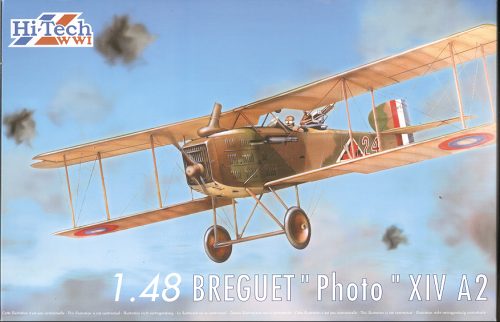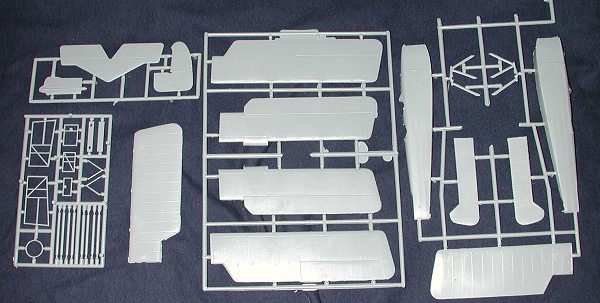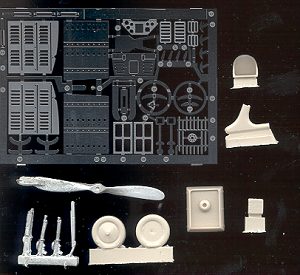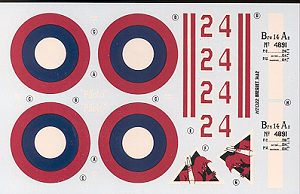
|
KIT: |
Hi-Tech 1/48 Breguet XIVA2 |
|
KIT # |
HT 022 |
|
PRICE: |
$39.98 ($33.96 at Squadron) |
|
DECALS: |
One aircraft |
|
REVIEWER: |
|
|
NOTES: |
Short run multi-media kit |

|
HISTORY |
Used throughout the war, the innovative Breguet Br.14 was a highly successful biplane used by the French, Belgian and American air services. Designed by Louis Breguet in 1916, it was one of the first aircraft constructed with duralumin in the airframe. Rugged and versatile, it was mass produced in several variations, including a seaplane model. Before the end of the war, the Br.14 saw service as a reconnaissance aircraft, a day/night bomber and an air ambulance. This was one of the best bombers the French used. Over 5,500 aircraft were produced up until 1926.
|
THE KIT |

 This kit is surprisingly not like
the majority of French short run kits that I have seen or built. First of all,
though the surface of the plastic is not glassy smooth, it is no where near as
rough and pebbly as what I've normally seen. Also surprisingly absent are large
sink mark areas and a ton of flash. To be sure, there is some flash, but not
anywhere near what I'm used to seeing. There is also no 'hills and valleys' when
it come to the wing rib detail. Things are pretty flat as one would expect on a
properly done canvas-covered aircraft.
This kit is surprisingly not like
the majority of French short run kits that I have seen or built. First of all,
though the surface of the plastic is not glassy smooth, it is no where near as
rough and pebbly as what I've normally seen. Also surprisingly absent are large
sink mark areas and a ton of flash. To be sure, there is some flash, but not
anywhere near what I'm used to seeing. There is also no 'hills and valleys' when
it come to the wing rib detail. Things are pretty flat as one would expect on a
properly done canvas-covered aircraft.
The kit comes with a very large sheet of etched metal to take care of many of the more highly detailed areas such as the louvered engine covers, instrument panel and much of the interior hardware. Resin is provided for the seat, exhaust wheels, nose section and what looks to be a seat. The prop, guns and tail skid are in metal, though these parts are not the best I've ever seen.
The instructions for the kit are just as brief as what one comes to expect from
Hi-Tech  and their subsidiary
companies. A number of smaller parts will need to be made from sprue and sheet
stock, but nothing major. There is a perfunctory rigging diagram that shows the
left forward portion of the plane, but it, as well as a few other guides in the
instructions are enough to accomplish the task. There is a nice three-view for
decal placement and a smaller five-view for painting. Decals look pretty decent
and are for a single aircraft of the 96th Aero Squadron in September 1918. I'm
pretty sure that there are no aftermarket decals for this aircraft so the kit
markings will have to do. A rather large reference section is provided where one
can go to get additional information on the aircraft.
and their subsidiary
companies. A number of smaller parts will need to be made from sprue and sheet
stock, but nothing major. There is a perfunctory rigging diagram that shows the
left forward portion of the plane, but it, as well as a few other guides in the
instructions are enough to accomplish the task. There is a nice three-view for
decal placement and a smaller five-view for painting. Decals look pretty decent
and are for a single aircraft of the 96th Aero Squadron in September 1918. I'm
pretty sure that there are no aftermarket decals for this aircraft so the kit
markings will have to do. A rather large reference section is provided where one
can go to get additional information on the aircraft.
|
CONCLUSIONS |
Frankly, this looks like a very nice kit and I'm quite interested in seeing what the finished kit looks like. Being the coward that I am, I've sent this to a qualified WWI modeler to build so that it can be given the proper care and treatment that it deserves!
You can find this kit and many others at

If you would like your product reviewed fairly and fairly quickly by a site that has well over 175,000 visitors a month, please contact me or see other details in the Note to Contributors.